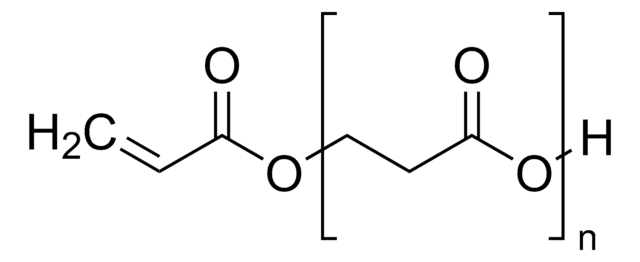552348
2-Carboxyethyl acrylate
contains 900-1100 ppm MEHQ as inhibitor
Sinônimo(s):
β-(Acryloyloxy)propionic acid, β-Carboxyethyl acrylate, 3-(Acryloyloxy)propionic acid, 3-Acryloyloxypropanoic acid, Acrylic acid 2-carboxyethyl ester, Acrylic acid dimer
About This Item
Produtos recomendados
contém
900-1100 ppm MEHQ as inhibitor
índice de refração
n20/D 1.457 (lit.)
pH
2.95 (10 wt. % in H2O)
pb
103 °C/19 mmHg (lit.)
solubilidade
H2O: soluble
densidade
1.214 g/mL at 25 °C (lit.)
temperatura de armazenamento
2-8°C
cadeia de caracteres SMILES
OC(=O)CCOC(=O)C=C
InChI
1S/C6H8O4/c1-2-6(9)10-4-3-5(7)8/h2H,1,3-4H2,(H,7,8)
chave InChI
CYUZOYPRAQASLN-UHFFFAOYSA-N
Categorias relacionadas
Aplicação
Características e benefícios
Palavra indicadora
Danger
Frases de perigo
Declarações de precaução
Classificações de perigo
Eye Dam. 1 - Skin Corr. 1B
Código de classe de armazenamento
8A - Combustible corrosive hazardous materials
Classe de risco de água (WGK)
WGK 3
Ponto de fulgor (°F)
230.0 °F - closed cup
Ponto de fulgor (°C)
110 °C - closed cup
Equipamento de proteção individual
Faceshields, Gloves, Goggles, type ABEK (EN14387) respirator filter
Certificados de análise (COA)
Busque Certificados de análise (COA) digitando o Número do Lote do produto. Os números de lote e remessa podem ser encontrados no rótulo de um produto após a palavra “Lot” ou “Batch”.
Já possui este produto?
Encontre a documentação dos produtos que você adquiriu recentemente na biblioteca de documentos.
Os clientes também visualizaram
Nossa equipe de cientistas tem experiência em todas as áreas de pesquisa, incluindo Life Sciences, ciência de materiais, síntese química, cromatografia, química analítica e muitas outras.
Entre em contato com a assistência técnica













![Bis[2-(methacryloyloxy)ethyl] phosphate](/deepweb/assets/sigmaaldrich/product/structures/128/336/4e7a3e38-338c-423e-95b8-70d9d1f8e121/640/4e7a3e38-338c-423e-95b8-70d9d1f8e121.png)

